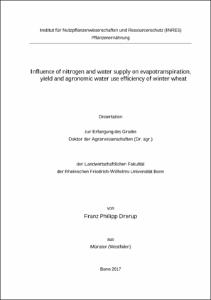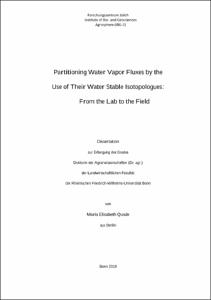Impact of different irrigation systems on water quality in peri-urban areas of Gujarat, India

Impact of different irrigation systems on water quality in peri-urban areas of Gujarat, India

| dc.contributor.author | Vangani, Ruchi | |
| dc.contributor.author | Saxena, Deepak | |
| dc.contributor.author | Gerber, Nicolas | |
| dc.contributor.author | Mavalankar, Dileep | |
| dc.contributor.author | von Braun, Joachim | |
| dc.date.accessioned | 2024-09-17T07:16:10Z | |
| dc.date.available | 2024-09-17T07:16:10Z | |
| dc.date.issued | 07.2016 | |
| dc.identifier.uri | https://hdl.handle.net/20.500.11811/12162 | |
| dc.description.abstract | The ever-growing population of India, along with the increasing competition for water for productive uses in different sectors – especially irrigated agriculture and related local water systems and drainage – poses a challenge in an effort to improve water quality and sanitation. In rural and peri-urban settings, where agriculture is one of the main sources of livelihood, the type of water use in irrigated agriculture has complex interactions with drinking water and sanitation. In particular, the multi-purpose character of irrigation and drainage infrastructure creates several interlinks between water, sanitation (WATSAN) and agriculture and there is a competition for water quantity between domestic water use and irrigated agriculture. This study looks at the determinants of the microbiological quality of stored drinking water among households residing in areas where communities use different types of irrigation water. The study used multiple tube fermentation method ‘Most Probable Number (MPN) technique, a WHO recommended technique, to identify thermotolerant fecal coliforms and E. coli in water in the laboratory (WHO 1993). Overall, we found that the microbiological water quality was poor. The stored water generally had very high levels of Escherichia coli (E. coli) contamination, 80% of the households had water in storage that could not be considered potable as per the World Health Organization (WHO) standards, and 73% of the households were using a contaminated water source. The quality of household storage water was largely unaffected by the major household socioeconomic characteristics, such as wealth, education level or social status. Households using surface water for irrigation had poor drinking water quality, even after controlling for hygiene, behavioral and community variables. Drinking water quality was positively impacted by proper storage and water treatment practices, such as reverse osmosis. Hygiene and sanitation indicators had mixed impacts on the quality of drinking water, and the impacts were largely driven by hygiene behavior rather than infrastructures. Community open defaecation and high village-household density deteriorates household storage water quality. | en |
| dc.format.extent | 41 | |
| dc.language.iso | eng | |
| dc.relation.ispartofseries | ZEF-Discussion Papers on Development Policy ; 219 | |
| dc.rights | In Copyright | |
| dc.rights.uri | http://rightsstatements.org/vocab/InC/1.0/ | |
| dc.subject | Irrigation water | |
| dc.subject | Water Quality | |
| dc.subject | Water Storage | |
| dc.subject | Water Treatment | |
| dc.subject | Sanitation and Hygiene | |
| dc.subject | Health Behaviour | |
| dc.subject | India | |
| dc.subject | Gujarat | |
| dc.subject.ddc | 300 Sozialwissenschaften, Soziologie, Anthropologie | |
| dc.subject.ddc | 320 Politik | |
| dc.subject.ddc | 330 Wirtschaft | |
| dc.title | Impact of different irrigation systems on water quality in peri-urban areas of Gujarat, India | |
| dc.type | Arbeitspapier | |
| dc.publisher.name | Center for Development Research (ZEF), University of Bonn | |
| dc.publisher.location | Bonn | |
| dc.rights.accessRights | openAccess | |
| dc.relation.eissn | 1436-9931 | |
| dc.relation.url | https://www.zef.de/fileadmin/user_upload/ZEF_dp_219.pdf | |
| ulbbn.pubtype | Zweitveröffentlichung | |
| dc.version | publishedVersion |







